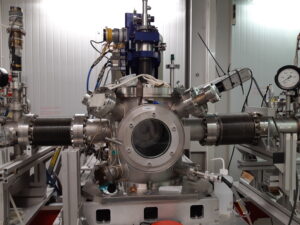X-ray absorption spectroscopy (XAS) @ LISA
LISA (Linea Italiana per la Spettroscopia d’Assorbimento) beamline at ESRF

LISA is a beamline installed on a so called “Single Bend” bending magnet source of the ESRF–EBS (Extremely Brilliant Source) ring. The ring electron beam has an energy of 6.03 GeV and a typical current of 200 mA (uniform filling mode). The magnet has a field of 0.85 T resulting in a critical energy of 20.6 keV. The source is estimated to have dimensions 23*3.5 μm2 RM and the first optic element is at 26m from it.
LISA consists in 3 lead hutches: the Optical Hutch (OH) containing the main optical elements, the first experimental hutch (EH1) with the instrumentation for experiments with a non-focused beam and a second experimental hutch (EH2) containing all the instrumentation for experiments with the focused beam. The x-ray optics consists in a first collimating mirror M1, followed by the monochromator and by a double toroid focusing mirror M2. Both mirrors have Pt and Si coatings. The monochromator is cooled via Liquid Nitrogen and is of the fixed-exit type; it is equipped with two pairs of flat Silicon crystals, Si (311) and Si (111) thus allowing to reach the energy ranges 4- 97 keV. The intensity is about 1010-1011 ph/s and the beam size, measured with the old source resulted to be below 200*200 μm2.
The beamline is equipped with instrumentation for X-ray Absorption Spectroscopy i.e. ion chambers and solid state detectors (2 High Purity Ge arrays of 12 and 13 elements, a 4 element SDD detector) a sample manipulator with 4 degrees of freedom (x, y, x and rotation) hosting a cryostat that can be used either with LN2 or LHe. A further manipulator with 2 degrees of freedom (z and rotation) is available for grazing incidence measurements. Additional instrumentation is available for measurements in Total Electron Yield, ReflEXAFS and XEOL detection schemes. The instrumentation can be installed in either of the two experimental hutches to be used either with a large homogeneous beam (EH1) or with the focused beam (EH2). A pulsed diode laser synchronized with the storage ring Radio Frequency can be used for pump and probe experiments in stroboscopic mode.
Support infrastructures
The beamline possess a chemical laboratory for the treatment of samples. The laboratory is equipped with a hut, a scale and a press for sample preparation as well as a filtering system for sample deposition Millipore membranes. A muffle oven capable to reach 1000 C is used for sample preparation or treatment and ultrasonic baths can be used for sample mixing. Surface analysis of the samples can be carried out via an AFM microscope.
Contact:
Francesco d’Acapito
Detailed information can be found on the beamline’s main homepage and on the main beamline publication (F. d’Acapito et al, J. Synchrotron Rad. 26 (2019), 551 doi 10.1107/S160057751801843X ).



